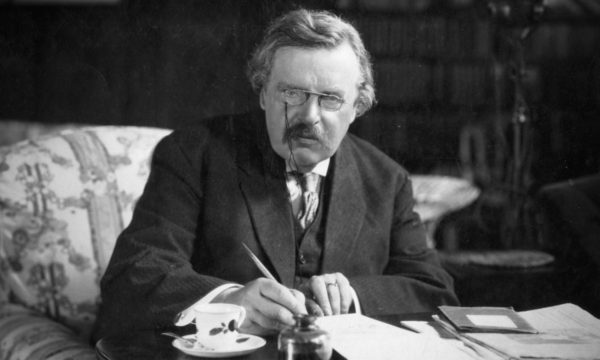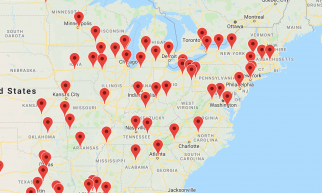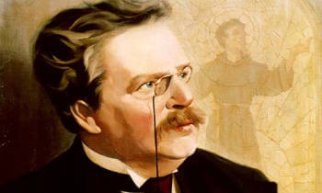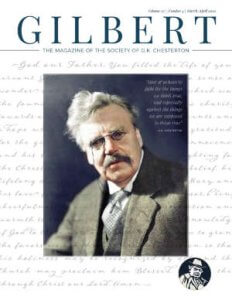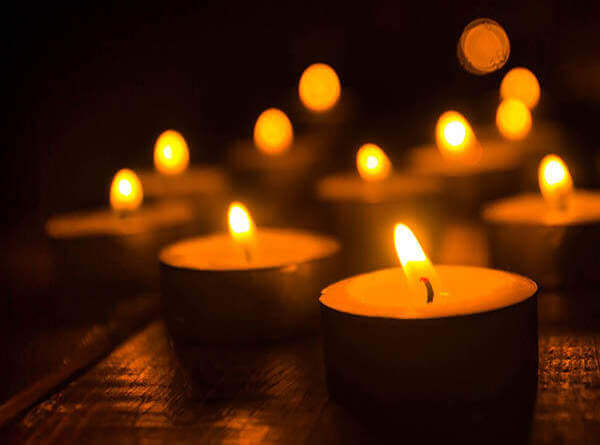When Chesterton was getting ready to travel to America for a speaking tour in 1921, he had to go to the American consulate about his passport. He was asked to answer certain questions. One was “Are you in favour of subverting the government of the United States by force?” His response: “I prefer to answer that question at the end of my tour and not the beginning.” There are other humorous stories from his trip that are told in this book, including his reaction to seeing the lights of Broadway: that they would be “a glorious garden of wonders…to any one was lucky enough to be unable to read.” But in spite of the fact that Chesterton argues that the road to international friendship is through “really understanding jokes” and that friendship between America and England is founded on “reciprocal ridicule,” this is a surprisingly serious work that raises serious questions.
Because Chesterton is a universal writer whose truths transcend national boundaries, we often assume that what he writes about England is also true of the United States. And often it is. However, the two countries are not the same. Chesterton uses every opportunity to point out the differences between the two, the characteristics that make each country unique. (“All good Americans wish to fight the representatives they have chosen. All good Englishmen wish to forget the representatives they have chosen.”) It is a fundamental doctrine of Chesterton that each country is unique and that its distinctive qualities, customs, and traditions should be preserved. Thus, visiting each unique place would broaden our minds, no?
No. Chesterton begins this book with one of his typical paradoxes: “I have never managed to lose my old conviction that travel narrows the mind.” Now why is that?
Because a man in his own home is inside all other men. It is a universal experience. He thinks the great thoughts. But a man traveling is amused or appalled by a thousand distractions and trivial things, even if they are very interesting. It is the traveler who thinks the small thoughts, and there is a danger that these secondary things could replace the primary things.
Chesterton, however, is able to resist this temptation. What I Saw in America begins as a travelogue but eventually becomes an extended reflection on what makes a nation a nation. However that is defined, America is the exception. It is a nation like no other. America, says Chesterton, is “the only nation in the world that is founded on a creed.” That creed is that all men are created equal. “There is no basis for democracy except in a dogma about the divine origin of man.” Thus, America is necessarily a religious nation. Chesterton says in fact, that it has “the soul of a church.” This is a elementary truth about our country that we neglect or actively ignore.
America is comprised mostly of rejects, of people who were thrown out or let go or escaped or disappeared from someplace else. In spite of such questionable pedigree, it is a land of great patriotic pride. It has always thought it important to imbue this patriotism, to Americanize every immigrant who has come here to make a new beginning. But it is a strange sort of patriotism that cannot define itself. And now the question is haunting us as we debate the virtues and vices of immigration, illegal or not, without ever having asked ourselves, What makes America America? Most of us share very little common heritage. Most of us have had to adopt this nation’s history. Most of us are the descendants of immigrants, some more recent than others. The present culture has no permanent glue to bind us; it can hardly be called a common culture. Just because we have to buy the same things does not mean we treasure the same things.
Chesterton predicted the probability of racial tension in America because of what the races have historically done to one another and the fears of what they might do in the future. Yet that admirable creed about equality remains the ideal that most every American believes in spite of the innumerable ways he fosters inequality in his support of the economic system, the political system, the educational system, and, most of all, that bizarre system of news and entertainment.
There is, says Chesterton, only one mood in America. He does not know whether to call it hustle or uplift, whether it is “the historic love of comrades or the last hysteria of the herd instinct,” but this American sociability is like Niagara: “It never stops” and it seems to have a constant pressure behind it. He describes the typical American as a “live wire,” which means he is not only active and full of energy but also sensitive: “the American uses his great practical powers upon very small provocation …there is a kind of sense of honour, like that of a duellist, in his readiness to be provoked.” Chesterton has perfectly described John Wayne, Clint Eastwood, and Rambo.
There were many things about America that Chesterton clearly loved, including every person he met. He was encouraged when he saw that the heartland was dotted with small farms. But he worried about the creeping industrialization he saw in the cities, “forests of brick” and a “labyrinth of lifeless things” that was eating up the landscape. It was well worth worrying about. Since Chesterton’s last visit, the family farm has been decimated. And Main Street has been further populated with “half-educated people” who have no connection to “the historic things” because they have been utterly separated from the land.

